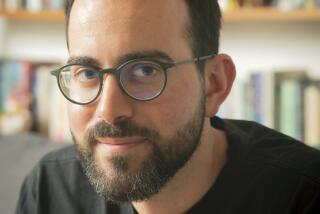Short on words, long on concepts
- Share via
It’s hard to imagine a more formidable subject for a biographer. Paul Adrien Maurice Dirac (1902-84) was a pioneer of quantum theory in the 1920s and 1930s and fully as obscure and bizarre as that revolution in physics. He was hard to know and uninterested in being known. To most interlocutors, scientific and otherwise (if numerous anecdotes are to be believed), he would customarily reply either “Yes,” “No” or “I don’t know.” Nevertheless, Graham Farmelo has managed to haul Dirac onstage in an affectionate and meticulously researched book that illuminates both his era and his science.
Though Dirac was born and raised in Bristol, U.K., his family’s roots were Swiss, and his father, an autocrat of the dinner table, insisted that Paul and his siblings address him in perfect French. In later life, to a few close acquaintances, Dirac attributed his glum taciturnity to this chilly paternal regime. He grew up unhappy at home and single-mindedly brilliant in the classroom, “a cold-hearted solipsist,” Farmelo writes, “. . . engaged only by mathematics, physics and engineering.”
He had no trouble (except in persuading his father to put up the money) getting into Cambridge in 1923, having already taught himself relativity. Nine years later, he ascended to the Lucasian chair of mathematics -- Isaac Newton’s chair, lately held by Stephen Hawking. By then, he had joined Niels Bohr and Werner Heisenberg in working out quantum mechanics and was revered (and loved) by both of them. He shared the 1933 Nobel prize in physics with Erwin Schrodinger, a rival mechanician who was less enamored. Dirac’s signal contribution was an equation describing the electron’s motion, and a consequent weird and eventually abandoned field theory conceiving of the world as a sea of negative-energy (i.e., negative-mass) electrons, omnipresent and thus undetectable. This was well before Carl Anderson at Caltech had seen his first positron -- the antimatter equivalent of the electron.
This is not easy stuff to discuss, although Farmelo, a physicist himself and the author of “It Must Be Beautiful: Great Equations of Modern Science,” does his best. Dirac was a visualizer and -- unlike Bohr, who all his life tried to make quantum physics accessible through language -- he trafficked in symbols. When laymen or journalists (or, for that matter, his Cambridge colleagues) begged him to explain what he was doing, he “gave his usual response of shaking his head or remarking unhelpfully that the new quantum theories ‘are built up from physical concepts which cannot be explained in words at all.’ ” But in his public lectures, he was a model of clarity and force, and his “The Principles of Quantum Mechanics” remains a classic, written in what Farmelo calls “deceptively plain language, which somehow seemed to reveal new insights on each reading, like a great poem.”
Farmelo is very good at portraying this locked-in, asocial creature, often with an eerie use of the future-perfect tense (“As Dirac will have heard . . .”), which has the virtue of putting the reader in the same room with people who are long gone. On Dirac’s arrival at tony Cambridge, “[his] social standing was given away by his cheap suit . . . A small and well-tended black moustache lay above his snaggled top teeth, his wan face topped with a thatch of black curly hair and dominated by his assertively pointed nose. Not quite six feet tall . . ., Dirac had bright eyes, a large forehead that revealed a receding hairline and, already, the slightest of stoops.”
This transcendent geekiness reminded me of my own introduction to academic physics in May 1989, when a physicist friend invited me to hear a talk by quantum theorist John Stewart Bell in Columbia University’s Pupin Hall. I got there early and sat in the steeply raked auditorium pretty much alone. Soon a side door opened below, and I was privileged to witness the renowned Columbia physics faculty file in, each one funnier-looking than the last.
In spite of his charmlessness and marked lack of interest in other human beings (Farmelo thinks he may have been autistic), Dirac was pursued by and eventually married the sister of Princeton theorist Eugene Wigner, and it was a good marriage. She disliked Cambridge, so in 1971 he moved to (of all places) Florida State University in Tallahassee, where he was the resident Grand Old Man until his death at age 82. Like his hero, Einstein, Dirac dropped from the mainstream of theoretical physics in later life; in his case, he was unable to accept “renormalization,” a kind of trick that got rid of anomalies in quantum electrodynamics.
Dirac was contemptuous of philosophy and, as many scientists do, professed atheism. But it was a narrow sort, mainly dismissive of religious orthodoxy. In notes he wrote in 1933, he embraces another creed: “[T]his article of faith is that the human race will continue to live for ever and will develop and progress without limit . . . Living is worthwhile if one can contribute in some small way to this endless chain of progress.”
On the Nobel website, there is a remarkable film clip of Dirac, signing in for the 1933 prize ceremony. Aware he is being photographed, he looks up at the camera, pauses for a few silent seconds, and then turns back to the register expressionless, except for what the French call a moue, a scarcely discernible pooch of his lower lip. It’s worth a thousand words.
More to Read
Sign up for our Book Club newsletter
Get the latest news, events and more from the Los Angeles Times Book Club, and help us get L.A. reading and talking.
You may occasionally receive promotional content from the Los Angeles Times.









